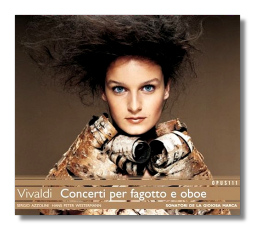
The Internet's Premier Classical Music Source
Related Links
- Vivaldi Reviews
- Latest Reviews
- More Reviews
-
By Composer
-
Collections
DVD & Blu-ray
Books
Concert Reviews
Articles/Interviews
Software
Audio
Search Amazon
Recommended Links
Site News
 CD Review
CD Review
Antonio Vivaldi

Concertos
- Bassoon Concerto in D minor, RV 481
- Bassoon Concerto in A minor, RV 498
- Bassoon Concerto in B Flat Major "La notte", RV 501
- Oboe Concerto in A minor, RV 461
- Oboe Concerto in C Major, RV 451
- Concerto in G Major for Oboe and Bassoon, RV 545
Sergio Azzolini, bassoon
Hans Peter Westermann, oboe
Sonatori de la Gioiosa Marca
Opus 111 OP30379 DDD 59:31
The word "athletic" comes to mind while listening to this program, an adjective suggested even before the music begins, as someone (not the bassoonist, I am guessing) noisily inhales before launching a typically Vivaldian onslaught. This is the Red Priest at his most lean and mean, and period performance at its most emphatic. Azzolini plays a modern reconstruction of a four-keyed bassoon which was in use during Vivaldi's time; Westermann plays an instrument of his own construction, but one apparently also similar to what the composer might have been familiar with. Both have a lean and buzzy tone quality, which makes them sound vehement in the faster movements. The small ensemble is named for the city of Treviso, where it is based – "Gioiosa Marca" being the old name for this region of Italy. The musicians play period instruments, and there are two violinists, and one musician each playing the viola, cello, violone, lute, and organ (or harpsichord). Thanks, perhaps, to the very close miking, no more than nine musicians sound like at least twice as many.
According to Louis Vatoison's annotations, Vivaldi's Concerto for Oboe and Bassoon is the only double concerto known to pair these two instruments. The composer assigns independent roles to his two soloists – there is complementarity but little dialogue between the two. In the dignified middle movement, Vivaldi dispenses with the orchestra entirely, and leaves his soloists to be accompanied by the basso continuo only. (Good use is made of the organ in this concerto.) Some of the remaining concertos are more familiar. The Bassoon Concerto in B Flat (RV 501), like one of Vivaldi's "Opus 10" flute concertos, is subtitled "Night," and the last three (of four) movements allude to ghosts, sleep, and finally, to the coming of the dawn. In this performance, these are all rather muscular phenomena!
This is another release in Opus 111's very enjoyable "Treasures of Piedmont" series – in fact, it is Volume 22! As with earlier volumes, the cover photography is distinctive. This time we are shown a wild-haired beauty with piercing blue eyes who appears to have been wrapped in birch bark!
Copyright © 2004, Raymond Tuttle




















